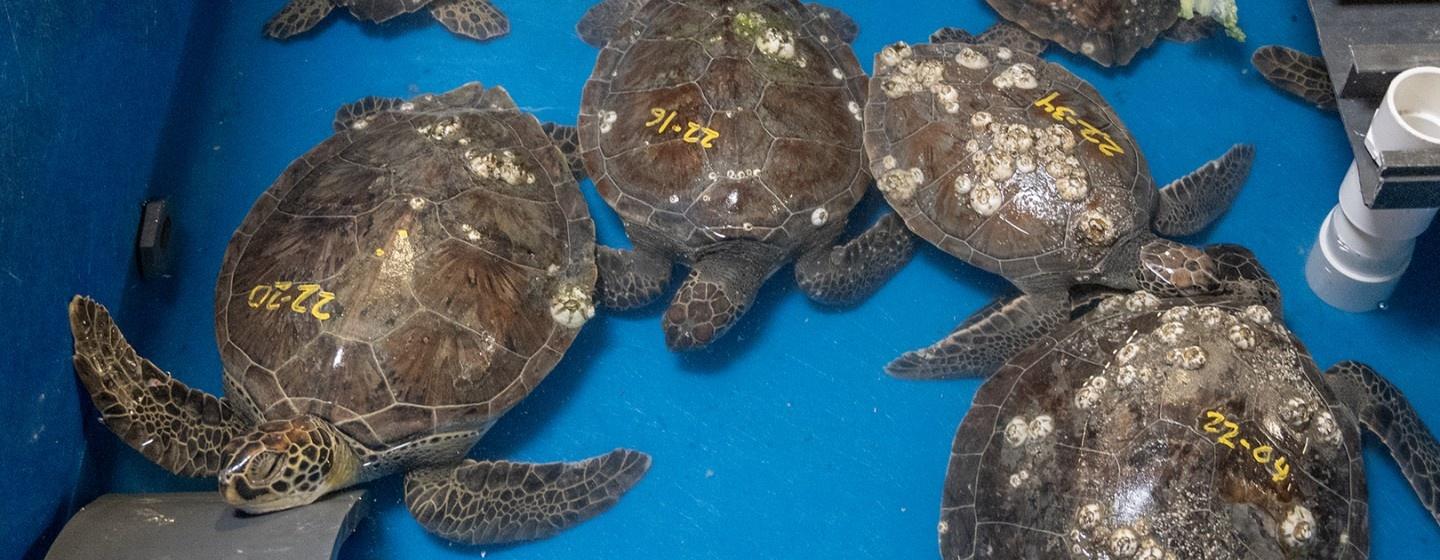Winter Weather Is Tough on Sea Turtles


Throughout the year, a network of volunteers along North Carolina’s Outer Banks watch for sick and injured sea turtles. Beach monitors bring the turtles to North Carolina aquariums, and volunteers and veterinary staff rehabilitate them and then release them back into the ocean.
But the extreme cold weather of the past few weeks has overwhelmed that volunteer network and the aquariums.
So far this season, the aquariums have cared for more than 200 turtles caught in frigid water temperatures. It’s called cold-stunning. Sadly, dozens more turtles have died.
“The turtle’s heart rate and other functions slow down, leaving them lethargic and unable to swim and even to lift their heads above water to breathe,” said Michele Lamping, aquarist and sea turtle specialist for the North Carolina Aquarium at Pine Knoll Shores, in a release. “Prolonged exposure can result in paralysis, and the turtles float on the surface or wash up on beaches.”
Sea turtles are cold-blooded, which means their surroundings determine their body temperature.
Green, loggerhead and Kemp’s ridley sea turtles use the shallow sounds along North Carolina’s coast as rich feeding grounds. That’s especially true of younger turtles.
Normally, when a turtle senses the temperatures are cooling, it heads for warmer waters. But when the temperature drops too quickly, the turtle misses its chance to leave and becomes cold-stunned.
Cold-stunning can affect sea turtles in different ways depending on how cold they get and for how long. In general, the colder the temperature and the longer the duration, the worse the effects.
The cold-stunning season starts in November and runs through March.
Biologists from Cape Lookout National Seashore and Cape Hatteras National Seashore, the North Carolina Wildlife Resources Commission and volunteers from sea turtle conservation groups like the Network for Endangered Sea Turtles locate, record and transport the turtles to care centers.
The aquariums receive turtles from several locations along the coast. Turtles taken to the North Carolina Aquarium at Pine Knoll Shores were recovered from Cape Lookout National Seashore, Core Sound and ocean-side areas.
Turtles found on the northern Outer Banks from Ocracoke to the Virginia line are taken to the Sea Turtle Assistance and Rehabilitation (STAR) Center at the North Carolina Aquarium at Roanoke Island.
In the southern part of the state, stranded turtles are taken to the Center for Marine Science and Technology (CMAST) in Morehead City for initial treatment. Turtles are then transferred to the Aquariums at Pine Knoll Shore or Fort Fisher, as well as the Karen Beasley Sea Turtle Rescue and Rehabilitation Center in Surf City.
During rehabilitation, the care team slowly warms up the turtles, making sure they can swim and lift their heads comfortably out of the water to breathe. A variety of foods is offered to tempt the turtle to eat. Technicians also administer other treatments prescribed by the veterinarians, including fluids, antibiotics, eye drops and wound care.
The turtle is ready for release once it’s healthy and gets a final check by the vet. But before it’s returned to the ocean, a small microchip is placed in the front flipper. That way if the turtle is stranded again, rehabbers and researchers can learn where the turtle was last seen and how much it has grown.
“Cold-stunned rehabilitation can take anywhere from a couple of weeks to several months, depending on the health of the turtle when it arrives,” said Amber Hitt, STAR Center coordinator at the North Carolina Aquarium at Roanoke Island. “We work closely with the vet team to make sure they are ready for release.”
Winter releases for turtles require partnerships because boats are needed to release the turtles offshore. That means warm waters near the Gulf Stream, which are usually 70 degrees Fahrenheit or above. Crews from the Duke University Marine Lab in Beaufort, the U.S. Coast Guard stations at Cape Hatteras and Fort Macon or private fishing vessels are called in.
If you see a turtle in the water or on the beach at this time of year that’s not moving or seems to be struggling, don’t push it back into the water or attempt to move it yourself. Call the Sea Turtle Stranding Hotline: